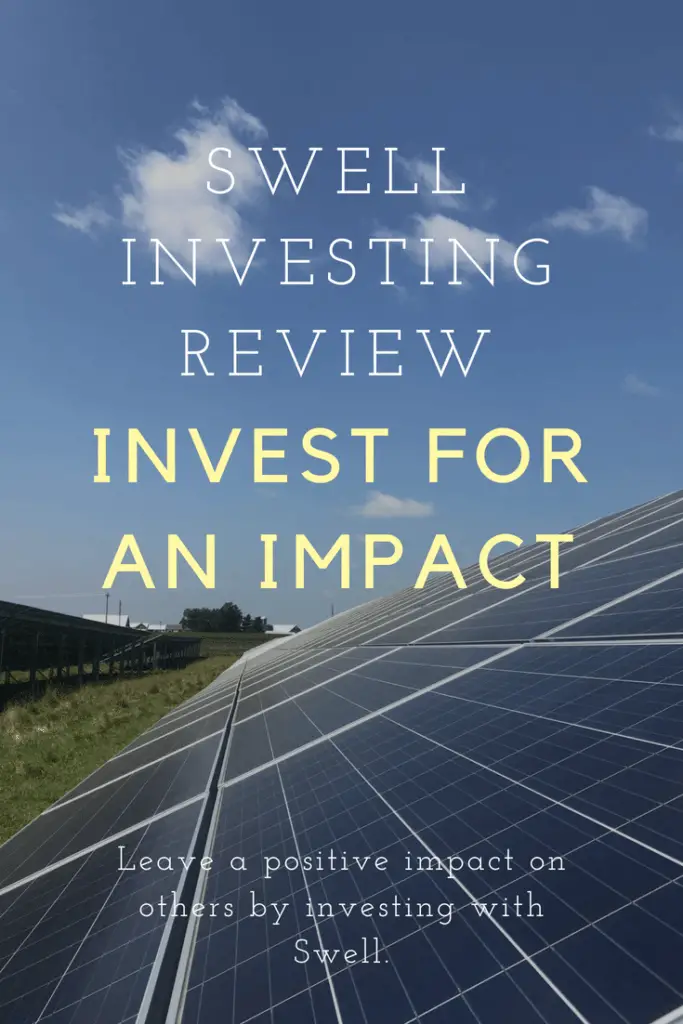Investing for impact has been a common trend over the last few years. I was very happy to see Swell Investing offer the opportunity to retail investors. Let’s get into our Swell Investing review to help you learn more about the platform.
Swell Investing Review: Passive Impact Investing
If you’re someone who frequently invests, you may have heard about impact investing. Swell Investing allows individual investors to invest in companies that make an impact. Fully automated. There simply isn’t enough dollars going to companies that are trying to leave a positive impact on our society. I was eager to this review of Swell as impact investing is near and dear to my heart.
What is impact investing? Put quite simply, impact investing refers to investments that are made into companies, organizations, and funds with the intention of generating social and environmental impacts alongside a financial return.
People like to call this “investing for impact”. Impact investing might just be a millennial retirement strategy worth considering. I’ve been trying to live off dividends and if I can do so by investing in companies making a difference… the more the better.
Try using our dividend investing calculator to see what it will take to live off dividends forever.
One impact quote that really motivates me to continue to do better is by Les Brown:
In every day, there are 1,440 minutes. That means we have 1,440 daily opportunities to make a positive impact.
-Les Brown
Swell Investing is one of many platforms that offers an impact investing app. Here are several other impact investing apps. Swell is definitely in our top 10 as a platform for impact investing.
Review of the Swell Interface
With the rise of this investing technique, a new impact investing platform called Swell has launched. Swell finds high-impact, high potential companies that are working towards innovative solutions to challenges that focus on a more positive future.
Swell Investing is geared towards investing for more than just profit. In this article, I will do a full Swell Investing review to see how good their platform is, how effective it is and more.
Overall, the setup progress isn’t too bad to get through, and once you’re finished, you’re ready to start investing with Swell. Once you’ve finished your profile, it’s time to choose what percentage of each category you’d like to invest in. Ideally, you’ll choose how you’d like to invest for impact to suit your particular beliefs.
Now before we get into this swell investing review, lets quickly look at who it’s best for, as well as the pros and cons. This product is best for hands-off investors, due to the lack of actual hands-on interaction.
It’s also great for investors who don’t have as many funds to get started, due to it’s fairly low starting investment amount of $50. It’s also best for people who are looking for a platform for impact investing.
Pros and Cons of Swell Investing
The pros are the fact that it allows for easy stock picking, thanks to the help of the robo-advisor. Another pro is the price. Swell has a low initial deposit, they don’t charge per trade, and they have a low annual fee.
The cons are the steep management fee of 0.75%. They also don’t allow for joint accounts, 401(k) rollover capacity, and they don’t have extraordinary customer service. To counter the management fee, here are some effective ways I saved in retirement fees.
Moving past that, the user interface is actually quite friendly. The bonus is, it even looks and functions great on mobile!
Most of the time working with a robo-advisor, you can’t be sure what kind of companies you’ll be investing in, which doesn’t matter to the typical investor. For impact investing, Swell is great because you know the types of companies that will be invested in.
Swell investing only puts companies in your portfolio that are doing good in the world. The real question we need to answer in this swell investing review is: does Swell really do a good job at investing or making an impact?
Swell Investing takes advantage of the concept of impact investing. From personal experience, I can tell you that while returns may not be as big as some other platforms for investing, it is fairly stable and you can know that your investments are actually making an impact by supporting companies that are working to make the world a better place.
One bad thing about Swell investing is that it doesn’t offer tax-sheltered accounts, like IRAs.
Alternatives to Swell
What this means is that investors are responsible for paying the taxes on their accounts. If you combine this with the 0.75 percent management fee, Swell can be on the more expensive side of investment choices. Compared to services such as Wealthsimple, Betterment, or even Ellevest, the fees can be quite harsh.
There’s also Blooom, which we’ve reviewed here. These sites have lower fees, and a lower account minimum, but they won’t be nearly as focused on impact investing and they are solely focused on optimizing and analyzing your 401(k) investments.
The best way to work towards making your decision is to have a financial plan created for yourself. We’ve covered an article here to help you figure out how to create your financial plan.
Swell thankfully has the upside of putting resources into singular stocks, giving the investors a chance to see precisely what organizations make up their portfolio. It also allows the individual allotment in each stock.
Other considerations with Swell
This is altogether different from the ETF contributing done by Wealthsimple, which basically puts resources into whole markets based on the index of that sector. It improves the straightforwardness of Swell’s portfolios.
Moreover, a speculator has at any rate constrained capacity to roll out improvements inside the arrangement of every portfolio, which is a noteworthy advantage of an individual stock venture.
Maybe the greatest disadvantage for investors with Swell is the nonappearance tax-loss gathering, which Wealthsimple offers.
It could drive speculators to confront capital increases assess liabilities, because of the dynamic idea of the Swell venture approach.
Swell is maybe best utilized as the socially capable allotment of a very much adjusted portfolio. Not at all like other robo-advisors, Swell doesn’t make an enhanced portfolio that puts resources into various market segments or distinctive resource classes, similar to securities and land. It’s entirely socially dependable contributing.
Swell Investing Investment Categories
Swell currently offers six portfolios, all of which represent unique segments of socially responsible investing and are comprised entirely of stocks and ADRs.
The six portfolios that you get with Swell investing are:
- Green Tech — Focused on energy efficiency, building desirable products and making a concerted effort to reduce the pull on the energy infrastructure. This portfolio is composed of 53 companies, including BorgWarner (BWA), Johnson Controls (JCI), and Tesla Motors (TSLA).
- Renewable Energy — Focused on companies that are harnessing natural resources (alternative energy sources) to power the world. In this portfolio, there are 64 companies, including Analog Devices (ADI), TransDigm Group (TDG) and Eaton Corp. (ETN). I like investing with Wunder Capital to invest directly in solar projects. You can check out our Wunder Capital review for more information. Save money on energy with these top energy saving products for your home.
- Zero Waste — Focused on companies that provide solutions for composting, recycling and creating new materials from recycled materials. This portfolio is made up of 37 companies, including Steel Dynamics, Inc. (STLD), FLIR Systems, Inc. (FLIR) and Parker-Hannifin Corp. (PH).
- Clean Water — Focused on companies engaged in conserving water, cleaning it up and streamlining systems. This portfolio contains 44 companies, including Albemarle Corp. (ALB), Parker-Hannifin Corp. (PH) and Martin Marietta Materials, Inc. (MLM).
- Healthy Living — Focused on companies engaged in food, fitness and new technologies that enable people to live longer, healthier lives. In this portfolio, there are 54 companies, including Align Technology, Inc. (ALGN), Garmin Ltd. (GRMN) and VF Corp. (VFC).
- Disease Eradication — Focused on pharmaceutical and biotech companies conducting R&D and developing novel approaches to combatting today’s biggest health challenges. This portfolio holds 68 companies, including Abbott Labs (ABT), Becton Dickinson & Co. (BDX), and AbbVie, Inc. (ABBV).
Swell Investing Review Conclusion
So, all in all, with this Swell investing review it should be pretty clear that you may not make as many returns on your investments, but again, there’s a lot more focus on impact investing.
It’s very important to know that you’ll be making more impactful changes with your money, despite possibly getting lower returns, you’ll know you’re doing good things in the world. Swell is definitely a platform that you should check out, especially considering the small fee to get started.
[maxbutton id=”3″]
If you’ve read our Swell investing review and you’re still not sure what you should do, we have plenty of wealth management resources for you to go through.
Here at Millionaire Mob, we’re dedicated to making sure you have all the information and resources you need to make a wise and educated decision to best suit your investing needs no matter what you are investing in. It could be investing in wine or impact investing.
Millionaire Mob is an early retirement blog focused on passive income, personal finance, dividend growth investing and travel hacking. With both a million rewards points and a million dollar net worth you can live a happier lifestyle.
Subscribe to the Millionaire Mob early retirement blog newsletter to find the best travel tips, dividend growth stocks, passive income ideas and more. Achieve the financially free lifestyle you’ve always wanted.
Join our community of over 3,000 mobsters seeking financial freedom. What are you waiting for?








No Comment